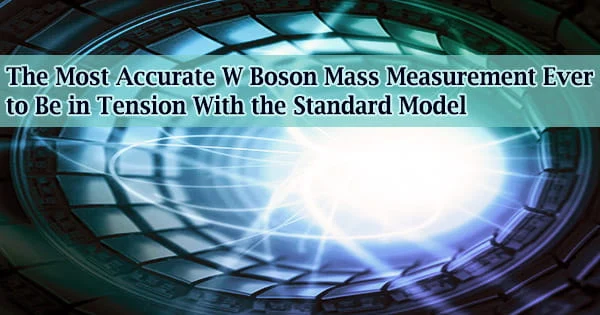Scientists from the CDF collaboration at the U.S. Department of Energy’s Fermi National Accelerator Laboratory revealed today that they have achieved the most exact measurement of the mass of the W boson, one of nature’s force-carrying particles, after ten years of rigorous research and inspection.
Scientists have now established the particle’s mass with an accuracy of 0.01 percent , twice as exact as the previous best measurement, using data obtained by Fermilab’s Collider Detector, or CDF. It’s the equivalent of weighing an 800-pound gorilla at 1.5 ounces.
Scientists may now verify the Standard Model of particle physics, the theoretical framework that describes nature at its most fundamental level, according to a new precision measurement published in the journal Science.
The result: The new mass value is in conflict with the value scientists find in the Standard Model utilizing experimental and theoretical inputs.
“The number of improvements and extra checking that went into our result is enormous,” said Ashutosh V. Kotwal of Duke University, who led this analysis and is one of the 400 scientists in the CDF collaboration.
“We took into account our improved understanding of our particle detector as well as advances in the theoretical and experimental understanding of the W boson’s interactions with other particles. When we finally unveiled the result, we found that it differed from the Standard Model prediction.”
Many collider experiments have produced measurements of the W boson mass over the last 40 years. These are challenging, complicated measurements, and they have achieved ever more precision. It took us many years to go through all the details and the needed checks. It is our most robust measurement to date, and the discrepancy between the measured and expected values persists.
Giorgio Chiarelli
If this measurement is confirmed, it indicates that the Standard Model computation may need to be improved or the model extended.
Many earlier W boson mass measurements agree with the new value, however there are notable discrepancies. Future measurements will be required to clarify the outcome.
“While this is an intriguing result, the measurement needs to be confirmed by another experiment before it can be interpreted fully,” said Fermilab Deputy Director Joe Lykken.
The W boson is a weak nuclear force messenger particle. It is in charge of the nuclear reactions that cause the sun to shine and particles to disintegrate. From 1985 through 2011, the CDF collaboration collected massive volumes of data containing W bosons using high-energy particle collisions produced by Fermilab’s Tevatron collider.
CDF physicist Chris Hays of the University of Oxford said, “The CDF measurement was performed over the course of many years, with the measured value hidden from the analyzers until the procedures were fully scrutinized. When we uncovered the value, it was a surprise.”
A W boson has a mass of around 80 times that of a proton, or about 80,000 MeV/c2. For more than 20 years, CDF researchers have tried to improve the precision of W boson mass measurements. Their most recent mass measurement’s center value and uncertainty are 80,433 +/- 9 MeV/c2.
This result is based on the whole dataset acquired at Fermilab’s Tevatron collider. It is based on the observation of 4.2 million W boson candidates, which is roughly four times the quantity utilized in the collaboration’s 2012 analysis.
“Many collider experiments have produced measurements of the W boson mass over the last 40 years,” said CDF co-spokesperson Giorgio Chiarelli, Italian National Institute for Nuclear Physics (INFN-Pisa).
These are challenging, complicated measurements, and they have achieved ever more precision. It took us many years to go through all the details and the needed checks. It is our most robust measurement to date, and the discrepancy between the measured and expected values persists.”
The team compared their findings to the best figure for the W boson mass predicted by the Standard Model, which is 80,357 6 MeV/c2.
This figure is based on complicated Standard Model calculations that intimately link the mass of the W boson to the masses of two additional particles: the top quark, discovered in 1995 at Fermilab’s Tevatron collider, and the Higgs boson, discovered in 2012 at CERN’s Large Hadron Collider.
The result, according to CDF co-spokesperson David Toback of Texas A&M, is an essential contribution to testing the veracity of the Standard Model. “It’s now up to the theoretical physics community and other experiments to follow up on this and shed light on this mystery,” he added.
“If the difference between the experimental and expected value is due to some kind of new particle or subatomic interaction, which is one of the possibilities, there’s a good chance it’s something that could be discovered in future experiments.”





